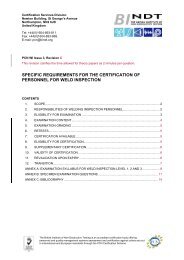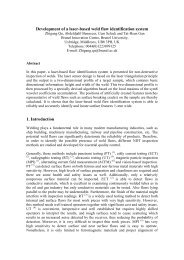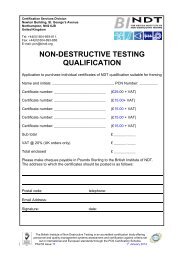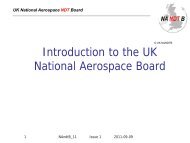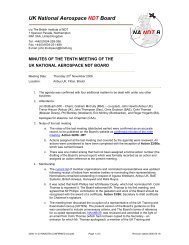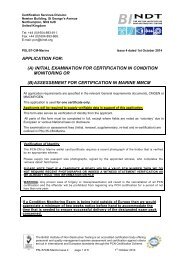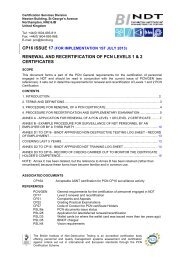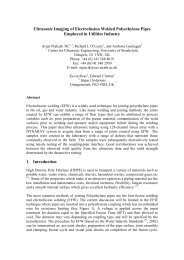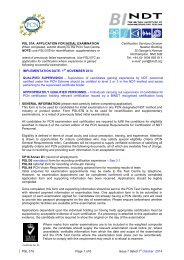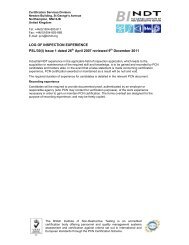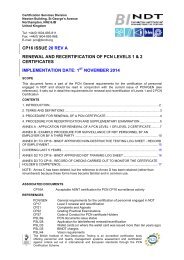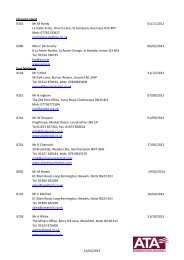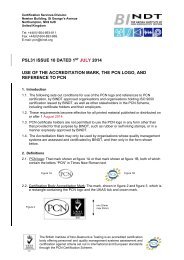Near Vision Requirements - BINDT
Near Vision Requirements - BINDT
Near Vision Requirements - BINDT
You also want an ePaper? Increase the reach of your titles
YUMPU automatically turns print PDFs into web optimized ePapers that Google loves.
UK National Aerospace NDT Board<br />
© UK NANDTB<br />
<strong>Near</strong> <strong>Vision</strong> <strong>Requirements</strong><br />
Presentation complied by UK<br />
NANDTB<br />
NAndtB_20 Issue 2 2010-04-15<br />
1
UK National Aerospace NDT Board<br />
Background<br />
© UK NANDTB<br />
EN4179:2005 required near vision acuity to Jaeger No. 1 or equivalent, not<br />
less than 30cm/12 in in at least one eye, natural or corrected.<br />
<strong>Vision</strong> acuity in EN4179:2009 changed to 20/25 (Snellen) at 16” (42cm) +/-<br />
1” (2.54cm) or equivalent in at least one eye, natural or corrected.<br />
There are methods other than Snellen for examining near vision eyesight<br />
acuity and there is considerable debate even within the medical field as to<br />
“equivalency” of vision requirements.<br />
Responsible Level 3’s will find it difficult to obtain clearly defined supporting<br />
medical evidence regarding the equivalency of vision requirements.<br />
The numerous potential avenues for equivalency provides scope for<br />
variation and error.<br />
NAndtB_20 Issue 2 2010-04-15 2
UK National Aerospace NDT Board<br />
Compliance<br />
EN4179/NAS410<br />
20/25 (Snellen) @ 16” +/- 1”<br />
© UK NANDTB<br />
Jaeger<br />
Chart<br />
Acceptable<br />
Equivalents<br />
Point<br />
Chart<br />
FAA 8500-1<br />
Other Other ‘Snellen’<br />
‘Snellen’ 16” charts 16”<br />
charts<br />
Sloan Characters<br />
BS4274-1<br />
(2003)<br />
Potential<br />
Others<br />
ISO8596<br />
(2009)<br />
#1 @<br />
≥12”<br />
N4 @<br />
≥16”<br />
‘Sans Serif’ font<br />
Distance reading standards<br />
Not suitable for near vision<br />
NAndtB_20 Issue 2 2010-04-15 3
UK National Aerospace NDT Board<br />
Global Standard<br />
• An agreed global standard for NDT personnel would eliminate<br />
the problems of variation and mitigate the risk of error. A<br />
standardised solution is required taking the following essential<br />
attributes in to consideration:<br />
• Optotype<br />
• Optotype size based upon 5 minutes of arc<br />
• Optotype spacing<br />
• Eye to optotype distance<br />
• Illumination<br />
• Acceptance criteria<br />
• Use of both eyes (as used for inspection)<br />
© UK NANDTB<br />
NAndtB_20 Issue 2 2010-04-15 4
UK National Aerospace NDT Board<br />
UK NANDTB Policy<br />
• Single Option: - Visual acuity tests to be carried out:<br />
• Using the UK NANDTB chart and NANDTB/20<br />
• Using the actual eye-wear used in the inspection process<br />
– Note: This includes corrective lenses and/or eye protection as normally used.<br />
• “Equivalents” not permitted within UK jurisdiction<br />
• Existing certification valid until expiration<br />
• Responsible Level 3 accountable for training and delegations<br />
Note: No Medical/Optical alternative test permitted (eg Optometrist Standard tests)<br />
• Functional NEAR VISION Acuity Test<br />
• Not for colour vision<br />
• Not medical examination<br />
– Employers should consider this separately – as for VDU operators etc<br />
© UK NANDTB<br />
NAndtB_20 Issue 2 2010-04-15 5
UK National Aerospace NDT Board<br />
The Test Chart<br />
© UK NANDTB<br />
NAndtB_20 Issue 12 2010-04-15 6
UK National Aerospace NDT Board<br />
Test Procedure<br />
• OUTLINE:<br />
© UK NANDTB<br />
• 1) Train/delegate personnel who will administer test<br />
• 2) Download/Print Chart and verify quality – keep secure<br />
• 3) Use one block of “E”s - better quality block<br />
• 4) Verify illumination level<br />
• 5) Ensure normal eyewear is used<br />
• 6) Set distance 400±25mm<br />
• 7) Establish the responses to be used<br />
• 8) Administer test – candidate using both eyes together<br />
• 9) Start at Line 1 working left to right and moving down lines<br />
• 10) Acceptance Level is 5 out of 5 up to & including line 9<br />
NAndtB_20 Issue 2 2010-04-15 7
UK National Aerospace NDT Board<br />
ADVANTAGES<br />
© UK NANDTB<br />
• Is Universal - No language/alphabet dependency<br />
• Based on vision acuity – not reading ability<br />
• Based on resolution of 6 mins of arc - as 20/25 Snellen<br />
• Can be administered locally<br />
• Directly controlled by Responsible Level 3<br />
• Basically “fail safe”<br />
• Administered under defined conditions<br />
• Auditable<br />
• Based on accepted scientific principles (eg BS 4274-1, ISO 8596)<br />
• Can be carried out in inspection area<br />
• May be carried out in conjunction with annual appraisal<br />
NAndtB_20 Issue 2 2010-04-15 8




